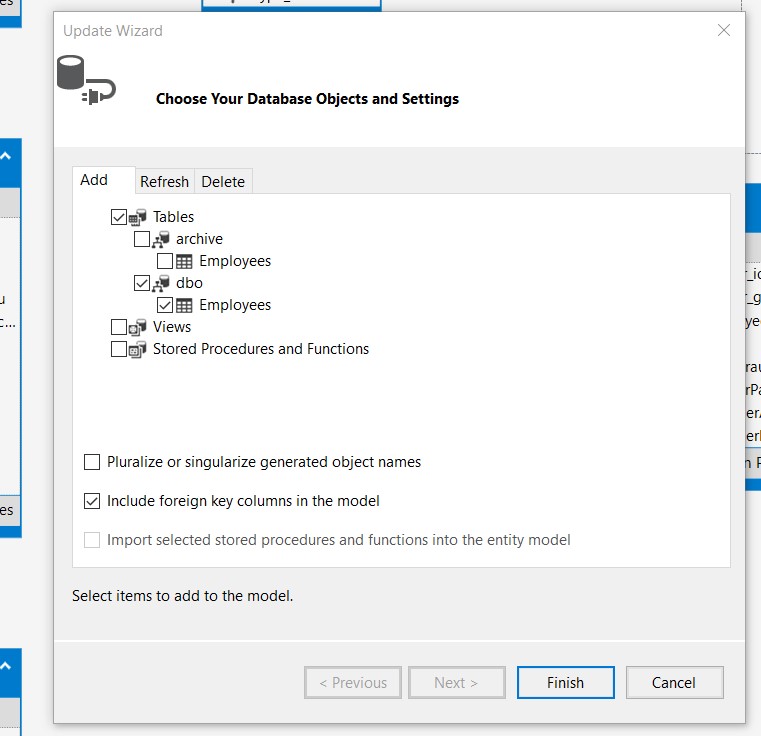I have the following model-first (is that what it's called?) diagram that I have made. I use T4 to generate the classes.

Now, I have a problem that causes Entity Framework to somehow append a "1" to the table name of the DatabaseSupporter entity. The database has been generated from this very model, and nothing has been modified.
I am trying to execute the following line:
_entities.DatabaseSupporters.SingleOrDefault(s => s.Id == myId);
The error I receive when executing that line (along with its inner exception below) is:
An exception of type 'System.Data.Entity.Core.EntityCommandExecutionException' occurred in mscorlib.dll but was not handled in user code.
Invalid object name 'dbo.DatabaseSupporter1'.
I tried fixing the problem with the following Fluent API code (notice the second line in the function that names the table explicitly to "DatabaseSupporter"), but with no luck.
protected override void OnModelCreating(System.Data.Entity.DbModelBuilder modelBuilder)
{
modelBuilder
.Entity<DatabaseSupporter>()
.HasOptional(f => f.DatabaseChatSession)
.WithOptionalPrincipal(s => s.DatabaseSupporter);
modelBuilder
.Entity<DatabaseSupporter>()
.Map(m =>
{
m.Property(s => s.Id)
.HasColumnName("Id");
m.ToTable("DatabaseSupporter");
});
modelBuilder
.Entity<DatabaseSupporter>()
.HasMany(s => s.DatabaseGroups)
.WithMany(g => g.DatabaseSupporters)
.Map(m =>
{
m.ToTable("DatabaseSupporterDatabaseGroup");
m.MapLeftKey("DatabaseGroups_Id");
m.MapRightKey("DatabaseSupporters_Id");
});
modelBuilder
.Entity<DatabaseGroup>()
.HasRequired(g => g.DatabaseChatProgram)
.WithMany(c => c.DatabaseGroups);
modelBuilder
.Entity<DatabaseGroup>()
.HasRequired(g => g.DatabaseOwner)
.WithMany(o => o.DatabaseGroups);
modelBuilder
.Entity<DatabaseOwner>()
.HasMany(o => o.DatabaseChatSessions)
.WithRequired(o => o.DatabaseOwner);
base.OnModelCreating(modelBuilder);
}
It should be mentioned that the Id property for every entity actually is a Guid.
I am using Entity Framework 6.0.2.
Any ideas?
Edit 1
Here's the generated DatabaseSupporter.cs file containing my DatabaseSupporter entity as requested in the comments.
//------------------------------------------------------------------------------
// <auto-generated>
// This code was generated from a template.
//
// Manual changes to this file may cause unexpected behavior in your application.
// Manual changes to this file will be overwritten if the code is regenerated.
// </auto-generated>
//------------------------------------------------------------------------------
namespace Coengage.Data.Entities
{
using System;
using System.Collections.Generic;
public partial class DatabaseSupporter
{
public DatabaseSupporter()
{
this.DatabaseGroups = new HashSet<DatabaseGroup>();
}
public bool IsActive { get; set; }
public string Username { get; set; }
public System.Guid Id { get; set; }
public virtual DatabaseChatSession DatabaseChatSession { get; set; }
public virtual ICollection<DatabaseGroup> DatabaseGroups { get; set; }
}
}
Edit 2
The errors started occuring after I added the many-to-many link between DatabaseSupporter and DatabaseGroup. Before that link, the Fluent code wasn't needed either.


T4to generate any classes before because I create all mine and then let Entity Framework create the database (code-first). Could you post yourPOCOclass or the method behind theT4generation? Attempting to alter the table name using fluent API will not work as its the class which is wrong. – Crupper.csfiles yes, as seen here: i.imgur.com/J3QQQ7C.png. Are those the ones you want to see? If so, which one? – IronworksDatabaseSupporter.csfile somewhere? The contents of that is the important bit. If not, search your code forDatabaseSupporter, that should find the solution to your issue. – CrupperInvalid object name 'dbo.DatabaseSupporter1'suggests it is looking for a real database or at least the web.config or app.config are looking for it. I would do Ctrl+F and see if "dbo.DatabaseSupporter1" is in the code. If not, check SQL Express doesn't have an existing database assuming your using SQL Server. Other than that I don't think I can help mate. Good luck. – CrupperDatabaseSupporter1- no results found. Entity Framework makes the class partial so that it is possible to extend if needed in separate files. However, I can assure you that I haven't made such extension. – Ironworks